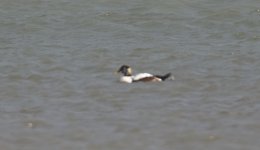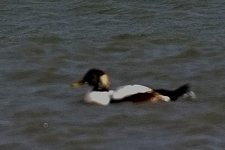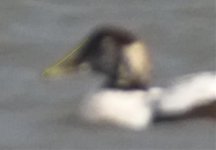-
Welcome to BirdForum, the internet's largest birding community with thousands of members from all over the world. The forums are dedicated to wild birds, birding, binoculars and equipment and all that goes with it.
Please register for an account to take part in the discussions in the forum, post your pictures in the gallery and more.
You are using an out of date browser. It may not display this or other websites correctly.
You should upgrade or use an alternative browser.
You should upgrade or use an alternative browser.
Eider uk ? (1 Viewer)
- Thread starter capdegat
- Start date
More options
Who Replied?Andy Adcock
Worst person on Birdforum

Surely not a pure Eider - if at all involved. To me it looks as if a Mallard is one of the parents...
My thought too,
Mallard x Shelduck?
A

I don't really see any problem with this as an Eider. They can look a bit weird when they're in transition.

Looks like a juv domestic.. Bill too long and flat for an Eider.. I don't think any ducks are moulting this time if the year... They're in full breeding plumage...
Although the OP doesn't say when this was taken, I'd suspect this is an immature male moving into adult plumage rather a moulting adult. The head shape is okay. Eider head shape is much more variable than is often illustrated in books and depends a lot on posture.
SteveClifton
Well-known member
Although the OP doesn't say when this was taken, I'd suspect this is an immature male moving into adult plumage rather a moulting adult. The head shape is okay. Eider head shape is much more variable than is often illustrated in books and depends a lot on posture.
Fully agree Andrew, especially your comments on head shape. On that, I think there is an illusion here, that the head doesn't have the typical wedge-shape of Eider, but I think it's just that-an illusion due to the photo being slightly out of focus. Look closely and 'read' the image allowing for the softness and lighting, and it looks fine for a drake nearing completion of its moult to adult plumage.
Suggestions of Mallard and/or Shelduck influence here is a bit 'out there'! No evidence to suggest either of those species for me
Last edited:
Although the OP doesn't say when this was taken, I'd suspect this is an immature male moving into adult plumage rather a moulting adult. The head shape is okay. Eider head shape is much more variable than is often illustrated in books and depends a lot on posture.
Yes but the bill is all wrong.. It's too flat.. I see Eiders week in and week out.. They're very angular triangular wedge-shaped bills.. Much thicker at the base than this bird..

Yes but the bill is all wrong.. It's too flat.. I see Eiders week in and week out.. They're very angular triangular wedge-shaped bills.. Much thicker at the base than this bird..
Well, I probably see them day in day out
As Steve says, it's hard to assess the exact shape of the bill on this photo though I don't see anything out of the ordinary myself.
That looks even less like an Eider.. It's not just the bill.. the head and body markings are all wrong too.. Eiders don't have a dark head and neck..I took the liberty and played a bit with the photo. Now it looks much more like an Eider. Should have done that in the first place...
Last edited:
RafaelMatias
Unknown member

Here you go guys:
http://www.oiseaux.net/photos/catherine.et.bernard.lanneluc/common.eider.3.html
http://brucedegraaf.zenfolio.com/p254992138/h159E2312#h159e2312
I too, think the apparently flat bill is the result of blurriness and photo artifacts (as can actually be confirmed by Carery's photo treatment).
http://www.oiseaux.net/photos/catherine.et.bernard.lanneluc/common.eider.3.html
http://brucedegraaf.zenfolio.com/p254992138/h159E2312#h159e2312
I too, think the apparently flat bill is the result of blurriness and photo artifacts (as can actually be confirmed by Carery's photo treatment).
SteveClifton
Well-known member
That looks even less like an Eider.. It's not just the bill.. the head and body markings are all wrong too.. Eiders don't have a dark head and neck..
From your comments, do you have much experience of Eiders in their full range of plumages? Immature drakes are extensively black/dark brown, and acquire full adult coloration gradually, with the head and breast often the last parts to lose the dark markings. There are other traces of brown rather than black elsewhere on this bird too, including on the rear flanks.
As for the head and bill profile, the attached shows something closer to the actual profile if you allow for the bill and forehead lobes being lighter in colour, and hence being 'lost' against the light-coloured sea.
Edit: I see Rafael has posted some images which prove exactly the point I was making :smoke:
Attachments
Last edited:
Joern Lehmhus
Well-known member
It does look odd, but I think that is due to the quality of the long shot photograph, colorwise and on the distribution of dark and light areas it certainly could be an Eider, even though head shape seems to be off in this single photo.
Colour and patternwise it doesn´t fit any Eider hybrid I know.
I wouldn´t identify anything for sure from this photo but apart from Eider being the best fit judging from this singel photo, it is also the likeliest choice....
Colour and patternwise it doesn´t fit any Eider hybrid I know.
I wouldn´t identify anything for sure from this photo but apart from Eider being the best fit judging from this singel photo, it is also the likeliest choice....
Users who are viewing this thread
Total: 2 (members: 0, guests: 2)






